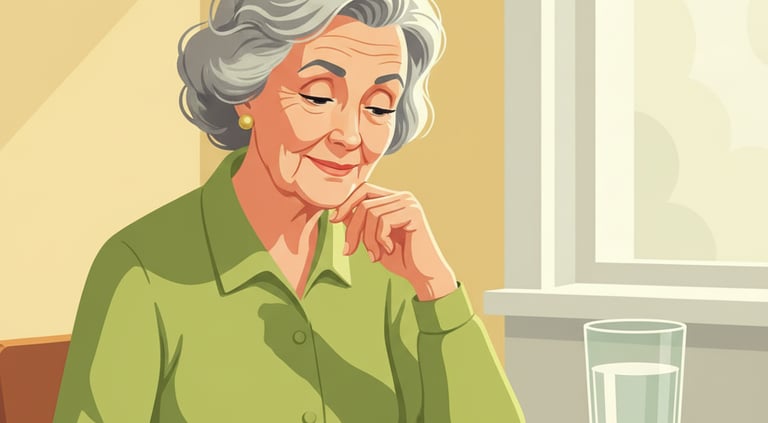FREE AI Analytics Tool for Health Reports and Scans available.
What Are the Top 5 Signs of Diabetes in Seniors?
Learn to recognize the 5 most common signs of diabetes in older adults. From frequent urination to blurry vision, find out why early detection is crucial and how it can prevent serious health complications.
USEFUL MEDICAL KNOWLEDGE
10/9/20253 min read


Introduction
As we get older, our bodies change in countless ways. It's easy to dismiss new aches, fatigue, or other shifts as a normal part of aging. I remember my own grandfather complaining that he was constantly thirsty and had to get up multiple times a night to use the bathroom. For a long time, he just shrugged it off, saying, "That's just life at 70." It wasn't until a doctor's visit that we realized these weren't just signs of getting older; they were classic symptoms of prediabetes, a precursor to Type 2 diabetes.
Diabetes can be especially challenging to diagnose in seniors because some of its most common symptoms—like fatigue or a need to urinate more often—can be mistaken for other age-related conditions. However, knowing what to look for can make a world of difference. Catching it early allows for a much better chance of managing the condition and preventing serious complications down the road.
So, let's cut through the confusion. Here are the top five signs of diabetes in seniors, and why you should pay close attention to them.
The Top 5 Signs You Shouldn't Ignore
These signs may appear gradually and seem harmless on their own, but if you notice them consistently, it's time to have a conversation with your doctor.
1. Frequent Urination and Increased Thirst
This is one of the most classic diabetes symptoms. When your blood sugar is high, your kidneys work overtime to filter and absorb the excess glucose. When they can't keep up, the excess sugar is excreted in your urine, along with fluids from your tissues. This can lead to dehydration, making you feel perpetually thirsty.
What to watch for: Waking up multiple times a night to use the bathroom, feeling a constant need to drink water, or even a dry mouth.
2. Unexplained Weight Loss
This can be a surprising symptom, especially since Type 2 diabetes is often associated with being overweight. When your body can't get enough energy from the glucose in your blood, it starts breaking down muscle and fat for fuel, leading to sudden, unexplained weight loss.
What to watch for: Losing weight without making any changes to your diet or exercise routine.
3. Blurry Vision
High blood sugar can cause the lens of your eye to swell, changing its shape and making it difficult to focus. While this symptom is often temporary and can improve once blood sugar is under control, it's a significant warning sign that something is wrong.
What to watch for: A gradual blurring of your vision that you can't explain with your current prescription.
4. Increased Hunger and Fatigue
This can feel like a contradiction, but it makes sense. Your body uses glucose for energy. If your insulin isn't working properly to get that glucose into your cells, you’ll feel tired and run down, even after eating. Your body will send signals that it needs more fuel, leading to increased hunger.
What to watch for: Feeling tired all the time, a lack of energy for your normal daily activities, and feeling hungry even after a meal.
5. Slow-Healing Wounds and Frequent Infections
High blood sugar levels can damage nerves and blood vessels, impairing circulation. This makes it harder for blood to reach areas that need to heal, slowing down the healing process for cuts, sores, and bruises. It also weakens your immune system, making you more susceptible to infections, especially of the skin and urinary tract.
What to watch for: A cut that takes an unusually long time to heal, or frequent yeast infections, skin infections, or urinary tract infections.
The Numbers Speak: Why This Matters
According to the Centers for Disease Control and Prevention (CDC), about 1 in 4 people over the age of 60 have diabetes. What's more concerning is that a significant number of them don’t even know they have it. The American Diabetes Association (ADA) reports that 28% of seniors with diabetes are undiagnosed, often because they, and their doctors, mistake the symptoms for normal signs of aging.
This is why paying attention to these signs is so critical. Early detection and management can prevent a cascade of serious health problems, including:
Heart disease and stroke
Kidney disease
Nerve damage (neuropathy)
Vision loss
By being vigilant and having an open conversation with your healthcare provider, you can take control. My grandfather’s story had a happy ending. With a few simple changes to his diet and lifestyle, he was able to reverse his prediabetes and live a long, healthy life, proving that knowing the signs is the first step toward prevention.
Join the conversation: What are some of the most surprising health changes you've noticed as you've gotten older? Share your experiences and tips below.
Disclaimer: This article is for informational purposes only and is not a substitute for professional medical advice, diagnosis, or treatment. Always consult with your physician or another qualified healthcare provider if you have any concerns about your health.

Address
Blk 8 Cantonment Close
SIngapore